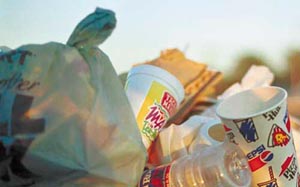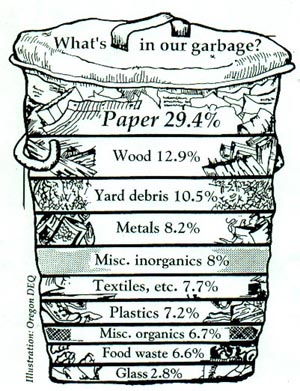
Links for Information about Trash
| Trash Facts | More Trash Facts | Did you Know??? |
| 10 Things you can do to save the Earth |
kinky clip in hair extensions uk rainbow braid hair extensions best hair extensions understanding the hair color wheel super long human hair wigs human hair kanekalon hair colors aliexpress 360 frontal wigs human hair wigs clip in hair extension shop london bella braided wigs amina lace wigs uk

--University of Oregon
"The Life of Litter. Decomposition Rate for Trash" The New York Times
Paper -- 2.5 months
Orange Peel --- 6 months
Milk Carton -- 5 years
Cigarette Butt -- 10-12 years
Plastic bag -- 10-20 years
Disposable diaper -- 75 years
Tin can -- 100 years
Beer can -- 200-500 years
Styrofoam -- Never (immortal)
Glass -- Never
Aluminum -- 100-500 Years
Plastic Containers -- 50-60 Years
* Each day, the average American city-dweller consumes 150 gallons of water, 3.3 pounds of food and 15 pounds of fossil fuels and produces 120 gallons of sewage, 3.4 pounds of garbage and 1.3 pounds of pollutants.
*The average citizen generates 3 to 5 pounds of garbage a day. Over the course of a year, that amounts to 1,400 pounds per person.
*Americans produce 154 million tons of garbage every year. That is enough to fill the New Orleans Superdome, top to bottom, twice a day, 365 days per year. Disposing of that waste cost about $4 billion in 1978. In many cities, expenditures for waste management were second only to those for education.
*Each year, Americans throw away approximately 60 billion cans, 28 billion bottles, 4 million tons of plastic, 10 million tons of yard waste, 40 million tons of paper, 100 million tires, and 3 million cars.
*Typically, solid waste contains about 42 percent paper, 23 percent yard and food wastes, 10 percent metals, 9 percent glass, 7 percent plastic, and 9 percent other materials. Although more than half of our solid waste could be recycled, we are currently recycling only about 10 percent. Denmark recycles an impressive 60 percent of its waste.
The single largest component of what people throw away is paper. The average American uses 580 pounds of paper a year, the highest rate of consumption in the world. Making that paper requires somewhere between three and six trees, each weighing close to 500 pounds.
*Solid waste management programs are outlined in the laws and rules of federal, state, and local governments. Federal guidance is provided in the Solid Waste Disposal Act of 1965 and the Resource Conservation and Recovery Act of 1970 and 1976. In addition, North Carolina has passed an Act to Improve the Management of Solid Waste. These laws will affect what we put in the garbage can.
*The amount of money spent on trash disposal in american schools is equal to that spent on new textbooks.
RETURN to Home Page